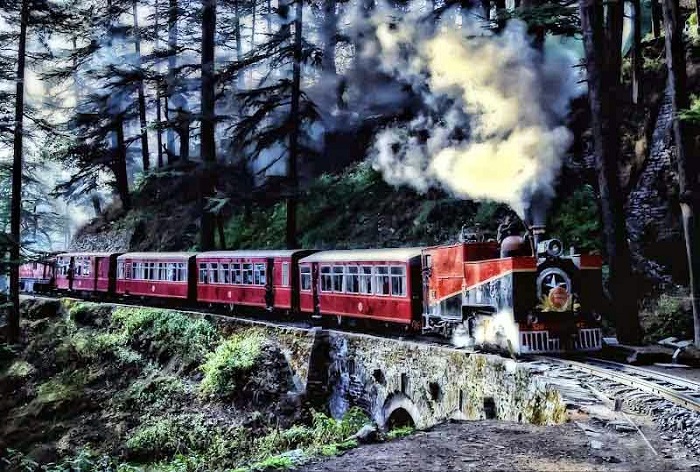India’s transportation system has largely been dominated by broad-gauge railways, but the broad-gauge can’t go everywhere and narrow-gauge railways have therefore carved their own niche, particularly in economically sustainable ways to transport people and goods through hilly areas. These lines, which have track gauges narrower than the usual broad gauge of 1,676 mm, helped connect remote places and assisted in economic development and tourism.
Historical Context
Narrow-gauge railways in India were first developed in the late 1800s and early 1900s. Princely states and private entities built narrow-gauge lines during this phase to cater to local conditions. The earliest instance known is of the Gaekwar’s Baroda State Railway(GBSR), founded by Maharaja Khanderao Gaekwad in the year 1862. This included an 8-mile stretch from Dabhoi to Miyagam, which was first pulled by oxen before locomotives were introduced.
Lesser known is the Dholpur–Sarmathura railway, promulgated by Maharaja Ram Singh of the Dholpur State in 1905 and formally opened in 1908. This line played a pivotal role on widening regional connectivity and providing transportation services for goods and passengersImportant
Narrow-Gauge Railways in India
Darjeeling Himalayan Railway(DHR): colloquially known as “Toy Train”, DHR is a 610 mm (2 ft) narrow-gauge railway, that runs between the New Jalpaiguri and Darjeeling towns in West Bengal. Founded in 1881, it became a Unesco world heritage site in 1999. The railway is famous for its picturesque views of the Eastern Himalayas and its engineering wonders such as the Batasia Loop. While there are of course trials, from nature and tourism alike, the DHR still preserves an experience of travel like no other, climbing the steep slopes of West Bengal and giving passengers stunning views of Mount Kanchenjunga.
Kalka–Shimla Railway: A 762 mm (2 ft 6 in) narrow-gauge railway line from Kalka in Haryana to Shimla, the capital city of Himachal Pradesh. Opened in 1903, it crosses some rugged mountainous terrain, with 102 tunnels and 864 bridges. The railway is famous for its scenic views and is a UNESCO World Heritage Site.
Nilgiri Mountain Railway (NMR): The NMR is a 1,000 mm (3 ft 3 3⁄8 in) metre-gauge railway that connects Mettupalayam and Udhagamandalam (Ooty) in Tamil Nadu. Opened in 1908, it is notable for its rack-and-pinion system, which allows trains to climb steep gradients. The NMR is a section of the UNESCO World Heritage Site “Mountain Railways of India”.
Kangra Valley Railway: This 762 mm (2 ft 6 in) narrow-gauge railway runs for 164 km (101.9 mi) from Pathankot in Punjab to Joginder Nagar in Himachal Pradesh portraying the mesmerizing view of Dhauladhar mountain range. This is the longest narrow-gauge line in India and also World Longest: 2 ft 6 in (762 mm) gauge railway. Ahju station, at 1,290 meters (4,230 ft), is the highest point on this line. The rail line is in the tentative lists for the UNESCO World Heritage Site.
Matheran Hill Railway: 610 mm (2 ft) narrow-gauge railway in Maharashtra running from Neral to Matheran Spanning 21 km (13 mi), it is famously known as a twisty, scenic road. The railway is a tentative World Heritage Site.
Modernization Efforts and Challenges
Indian Railways has in recent years been on an unprecedented drive to upgrade, spending more than $22 billion in the current fiscal year to improve capacity, speed and safety. This modernization is in line with the government’s ambition for railways to achieve net zero carbon emissions by 2030. A large number of narrow-gauge lines are being converted to broad gauge, under Project Unigauge, to provide seamless connectivity to all parts of the country as part of this drive.
The Indian Railways is dedicating efforts towards enhancing regional connectivity by converting small gauge railway lines, such as the recently defunct Dholpur–Sarmathura Railway (which made its last run in March 2023), to broad gauge.
Likewise, the narrow-gauge lines of the Gaekwar’s Baroda State Railway already are being converted to broad gauge for better operational efficiency and integration with the national railway network.
Heritage and Tourism
Although many narrow-gauge railways were converted to broad-gauge, several have been preserved as a result of their heritage status and tourism potential. One such tourist attraction is the Darjeeling Himalayan Railway, which still attracts tourists from around the globe and takes you across scenic mountains and is a window to the Indian colonial past. The train sets off from New Jalpaiguri station in Siliguri and takes seven and a half hours to get to Darjeeling, reaching a top speed of 4.4 mph. University Road, Darjeeling Ghoom Darjeeling Railway for mountain village, tea plantations and high altitude stations like Ghum with aroma of the deserts have become coveted things during the journey.
The Nilgiri Mountain Railway is another scenic passenger train experience, as it climbs through the verdant hills of Tamil Nadu and produces sweeping views of the Western Ghats.
Given the above series of events, you should be clear about the current and future status of chatbots on $GPT.
As of January 2025, several narrow-gauge lines remain operational in India, primarily serving as heritage railways and tourist attractions. However, the majority are either closed or undergoing conversion to broad gauge to enhance operational efficiency and integrate with the national railway network.
For More Articles Click







0 Comments